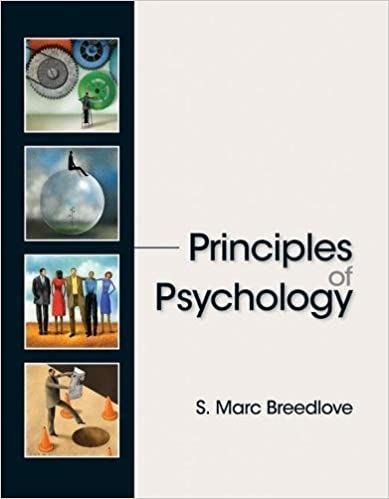Organized around four well established core principles, Principles of Psychology provides students with a framework to understand the science of behavior. Written in a conversational style, the text is organized around the following four well established principles that serve as touchstones for the field of psychology:
The mind is a process at work in a physical machine, the brain.
We are consciously aware of only a fraction of our mental activity.
We constantly modify our behavior, beliefs, and attitudes according to what we perceive about the people around us.
Experience physically alters the structure and function of the brain.
With these four principles as a framework for the text, Principles of Psychology emphasizes that psychology is a science through discussion of relevant big picture and proven concepts and cutting edge research based investigations that examine behavioral, psychological, and neuroscience experiments. By presenting data and facts from other scientific disciplines, as well as real world vignettes and stories, Marc Breedlove teaches the reader how to think critically and scientifically about the underlying mechanisms of behavior.
In Text Features
Vignette: Each chapter begins with a story, an instance when behavior has a big impact on someone's life. The chapter returns to the vignette several times as we cover findings that relate to that particular case.
Researchers at Work: In every chapter, important discoveries are explained and illustrated to highlight the process of experimentation and hypothesis testing. Over the course of the book, the progression of experiments provides an increasingly sharper picture of the factors shaping behavior.
Skeptic at Large: Intended to sharpen the student's critical thinking skills, these boxes explore a widespread misconception and demonstrate how scientific research disproves it. The exploration of scientific experimentation also reinforces the Researchers at Work feature.
Psychology in Everyday Life: These are topics where knowledge of psychology might be applicable to everyday life, such as whether people with schizophrenia are violent, the importance of "blind" auditions for musicians, how to stop smoking, or how conditioned taste aversion might cause you to stop eating sushi when you used to love it.
The Cutting Edge: Just prior to the end of every chapter, this feature explores an exciting report of current research. Showing students these vibrant and bold experiments will emphasize that psychology research remains alive and well.
Think Like a Psychologist: Principles in Action: To close each chapter, each principle is related back to the vignette to show the student that when they observe an interesting behavior they can recall and apply the four principles. If they can do this, they will indeed be thinking like a psychologist.
چکیده فارسی
«اصول روانشناسی» که حول چهار اصل اصلی به خوبی تثبیت شده سازماندهی شده است، چارچوبی برای درک علم رفتار در اختیار دانش آموزان قرار می دهد. متن به سبک محاوره ای نوشته شده است، متن بر اساس چهار اصل به خوبی تثبیت شده زیر سازماندهی شده است که به عنوان سنگ محک برای حوزه روانشناسی عمل می کند:
ذهن فرآیندی است که در یک ماشین فیزیکی، مغز در حال کار است.
ما آگاهانه فقط از کسری از فعالیت ذهنی خود آگاه هستیم.
ما دائماً رفتار، باورها و نگرش های خود را بر اساس آنچه در مورد افراد اطراف خود می بینیم، تغییر می دهیم.
تجربه از نظر فیزیکی ساختار و عملکرد مغز را تغییر می دهد.
با استفاده از این چهار اصل به عنوان چارچوبی برای متن، اصول روانشناسی تاکید می کند که روانشناسی علمی است از طریق بحث در مورد تصویر بزرگ مرتبط و مفاهیم اثبات شده و تحقیقات مبتنی بر تحقیقات پیشرفته که به بررسی رفتاری، روانشناسی و علوم اعصاب می پردازد. آزمایش. مارک بریدلاو با ارائه دادهها و حقایق از سایر رشتههای علمی، و همچنین داستانها و داستانهای دنیای واقعی، به خواننده میآموزد که چگونه به طور انتقادی و علمی در مورد مکانیسمهای زیربنایی رفتار فکر کند.
در ویژگی های متن
وینیت: هر فصل با یک داستان شروع میشود، نمونهای که رفتار تأثیر زیادی بر زندگی شخصی دارد. با پوشش یافتههای مربوط به آن مورد خاص، این فصل چندین بار به داستان بازمیگردد.
محققان در کار: در هر فصل، اکتشافات مهم برای برجسته کردن فرآیند آزمایش و آزمون فرضیه توضیح داده شده و نشان داده شده است. در طول کتاب، پیشرفت آزمایشها تصویر واضحتری از عوامل شکلدهنده رفتار ارائه میدهد.
شکاک در بزرگ: این جعبهها با هدف تقویت مهارتهای تفکر انتقادی دانشآموز، یک تصور غلط گسترده را بررسی میکنند و نشان میدهند که چگونه تحقیقات علمی آن را رد میکند. کاوش در آزمایش های علمی نیز ویژگی پژوهشگران در کار را تقویت می کند.
روانشناسی در زندگی روزمره: اینها موضوعاتی هستند که دانش روانشناسی ممکن است در زندگی روزمره قابل استفاده باشد، مانند اینکه آیا افراد مبتلا به اسکیزوفرنی خشن هستند یا خیر، اهمیت تستهای "کور" برای نوازندگان، نحوه ترک سیگار، یا اینکه چگونه بیزاری از طعم مشروط ممکن است باعث شود در زمانی که سوشی را دوست داشتید، از خوردن آن دست بکشید.
The Cutting Edge: درست قبل از پایان هر فصل، این ویژگی گزارشی هیجان انگیز از تحقیقات فعلی را بررسی می کند. نشان دادن این آزمایشهای پر جنب و جوش و جسورانه به دانشآموزان، بر این نکته تأکید میکند که تحقیقات روانشناسی همچنان زنده و پایدار است.
مثل یک روانشناس فکر کنید: اصول در عمل: برای پایان دادن به هر فصل، هر اصل به تصویر مربوط می شود تا به دانش آموز نشان دهد که وقتی رفتار جالبی را مشاهده می کند، می تواند چهار اصل را به خاطر بیاورد و به کار گیرد. اگر آنها بتوانند این کار را انجام دهند، در واقع مانند یک روانشناس فکر می کنند.
ادامه ...
بستن ...
ISBN-13: 978-0199329366
ISBN-10: 0199329362
ادامه ...
بستن ...










